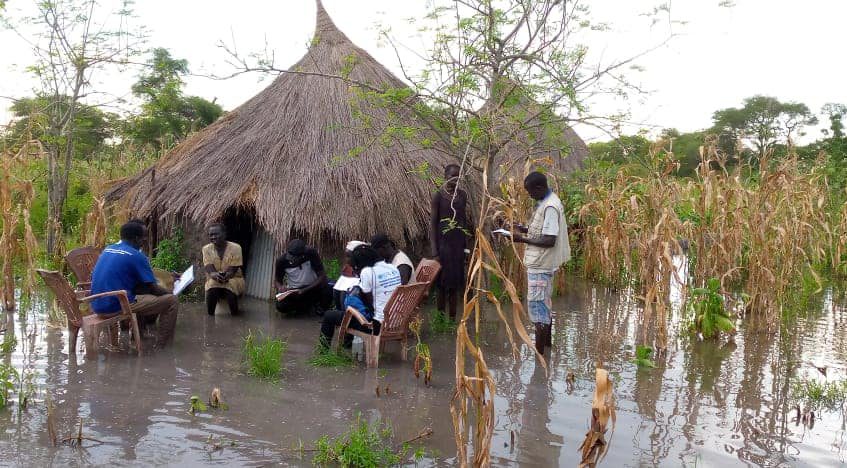You are here: Home | Humanitarian | National News | News | Access to 5 counties made extremely difficult or impossible in 2020 -OCHA

Humanitarian workers conducted assessment in a flood-affected village in South Sudan. 2020. (Photo: Hope Restoration South Sudan)
Humanitarian organizations were not able to efficiently support thousands of people in five Counties across South Sudan in 2020, the UN Office for the Coordination of Humanitarian Assistance has disclosed.
“Out of the 7.5 million people in need of humanitarian assistance in 2020, approximately 254,000 people lived in the counties with high access constraints, including some 215,000 targeted with assistance,” an assessment report released on Friday, January 8, indicated.
It said despite some improvements in humanitarian access since the establishment of the transitional government in February 2020, “access continued to be constrained by sub-national violence, bureaucratic impediments, operational interference, and violence against humanitarian personnel and assets.”
The report revealed that up to 60 per cent of the roads in the country were cut off, hindering humanitarian organizations from accessing people in need of assistance and people from receiving aid.
In 34 Counties, it said thousands of people were occasionally reached with humanitarian assistance due to armed groups, checkpoints, bureaucratic or other access impediments.
“With adequate resources, partners would be able to reach all or nearly all targeted people in need,” it said
It further disclosed that 39 Counties witnessed regular medium access constraints due to armed groups, checkpoints, bureaucratic or other access impediments -forcing partners to reach roughly half of the targeted population.
“Operations continue in these areas with regular restrictions,” UN OCHA reported.
Aid groups said access to five counties were extremely difficult or impossible in 2020 as a result of active hostilities, constant violence against humanitarian personnel and assets, and the physical environment.
These areas include; Longochuk, Maiwut, and Panyikang in Upper Nile; Mundri East in Western Equatoria; and Rumbek North in Lakes state.
They also include Jonglei and the Greater Pibor Administrative Area where a surge in sub-national violence was witnessed.
“Operations in these areas are often severely restricted or impossible. Even with adequate resources, partners would be unable to reach more than a minority of targeted people in need,” it revealed.
Aid organizations also attributed much of the access constraints to coronavirus restrictions imposed to curb the spread of the virus and the devastating impact of the rainy season.
In 2019, the UN classified a total of 34 out of 78 counties as facing low-level access constraints, compared to 44 counties i
The report was generated from a structured focus group discussions conducted in mid-2020 to determine levels of perceived humanitarian access across the 78 counties of South Sudan.
According to UN OCHA, the results will enable the development of local access strategies to address the most common or challenging impediments in 2021.
It is expected to inform high-level advocacy on access and guide operational planning to support targeted response to people’s humanitarian needs in areas with severe access constraints.
Last month, the Integrated Food Security Phase Classification estimated that between October and November last year, up to 6.5 million people faced severe acute food insecurity, and require urgent assistance.
The number is projected to grow to 7.24 million between April and July 2021.
The government and aid organizations revealed that tens of thousands of people are likely to face acute malnutrition and even mortality in Pibor, Akobo, Aweil South, Tonj East, Tonj North and Tonj South.
Support Eye Radio, the first independent radio broadcaster of news, information & entertainment in South Sudan.
Make a monthly or a one off contribution.
Copyright 2024. All rights reserved. Eye Radio is a product of Eye Media Limited.